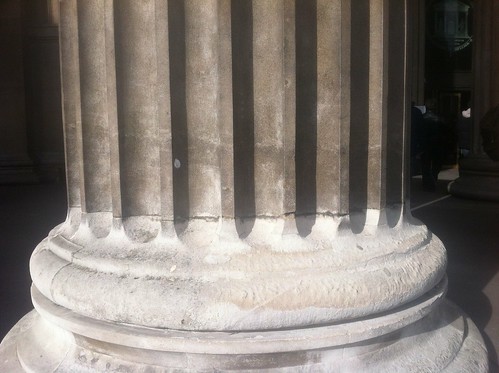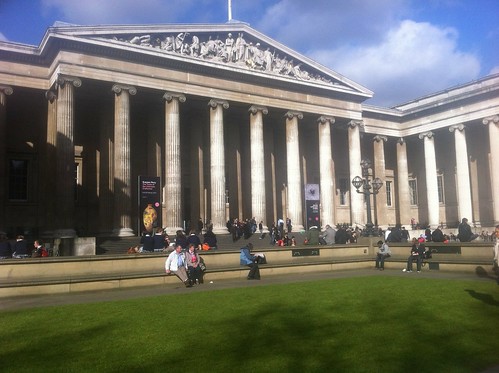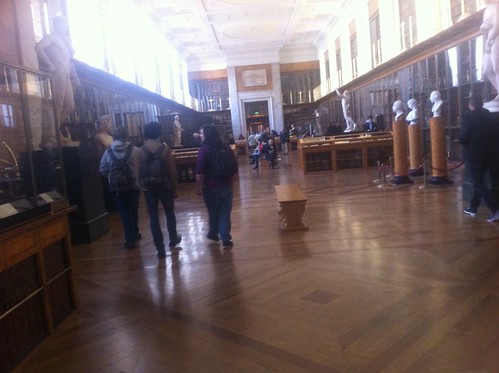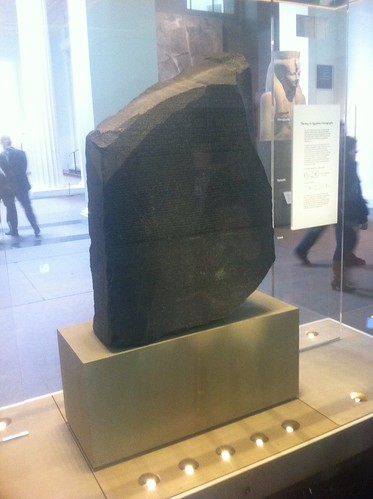Thinking I was being too obvious, particularly having just told Twitter I was in Russell Square, I tweeted a photo of the base of a pillar as a clue to my next location.
I hadn’t intended this to be a stop on my trip as I’ve been before but, having had lunch by the fountain in Russell Square Gardens, I couldn’t resist a few minutes inside the British Museum.
I made my way to the Enlightenment Gallery. I enjoy this room, which usually seems calm (relative to the bustling Egyptian galleries opposite) and is full of interesting small pieces including scientific instruments. I hadn’t realised but I had just missed the “eye–opener gallery tour” (Free; Daily, 12.30; for 30–40 minutes).
Having seen the King’s Library in the British Library earlier that morning, I was interested to read that this room was the previous location of the same library. Apparently its donation caused a building programme to expand the British Museum and this room was built in 1827 specifically to house the new library.
After the King’s Library was moved to the British Library in 1997, a restoration of the gallery in 2000-3 “revived the original room to its previous glory of the 1820s”:
Repairs to the oak and mahogany floor and classical architectural features have refreshed the space. Hundreds of square metres of plaster were cleaned to restore the yellow and gold ornamentation and the re-gilded balcony.
Two hundred kilometres of wiring (twice round the M25 motorway) enabled a subtle lighting system to be installed, which aims to complement the newly-restored colour scheme.
The result was that two centuries of use and London grime were washed away and a major permanent exhibition, using thousands of objects from the Museum collection to show how people understood their world in the Age of Enlightenment, was created.
To my surprise, no one had yet guessed my location! I tweeted a second clue, a row of postcards of the Rosetta Stone on sale in the museum shop, and Courtney Williams was quick to guess my location. Showing considerable wisdom, she tweeted:
I’d ask if I won a prize, but it was enough of a prize to take part
I said that was fortunate!
On my way out of the museum I popped my head around the corner to the Rosetta Stone.
The story of this stone is fairly famous and often, in my experience, mentioned in talks on cryptography.
After the stone was rediscovered in 1799 by Napoleon’s soldiers near the town of el-Rashid (Rosetta). The stone passed to British hands in the Treaty of Alexandria (1801), being exhibited in the British Museum since 1802 (apart from briefly moving to a safe location during wartime). The Enlightenment Gallery houses a replica of the stone positioned as originally displayed.
The stone carries a decree, crucially:
inscribed on the stone three times, in hieroglyphic (suitable for a priestly decree), demotic (the native script used for daily purposes), and Greek (the language of the administration).
The repetition of the same text in three languages was important to modern understanding of hieroglyphs, and through them our understanding of ancient Egyptian culture.
Thomas Young, an English physicist, was the first to show that some of the hieroglyphs on the Rosetta Stone wrote the sounds of a royal name, that of Ptolemy. The French scholar Jean-François Champollion then realized that hieroglyphs recorded the sound of the Egyptian language.
After my short but enjoyable visit to the museum, I moved on to my next location, which I will save for a later post.




